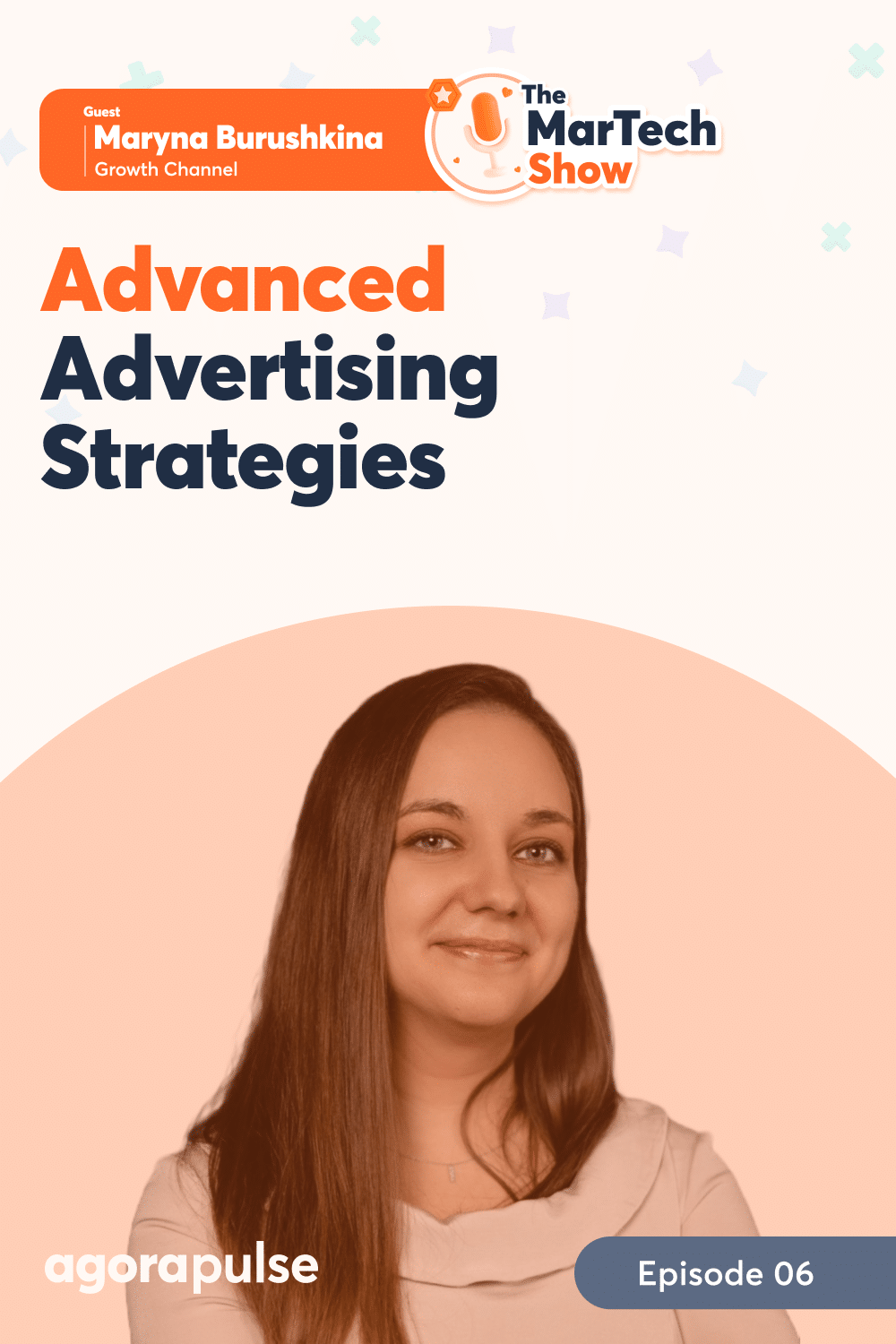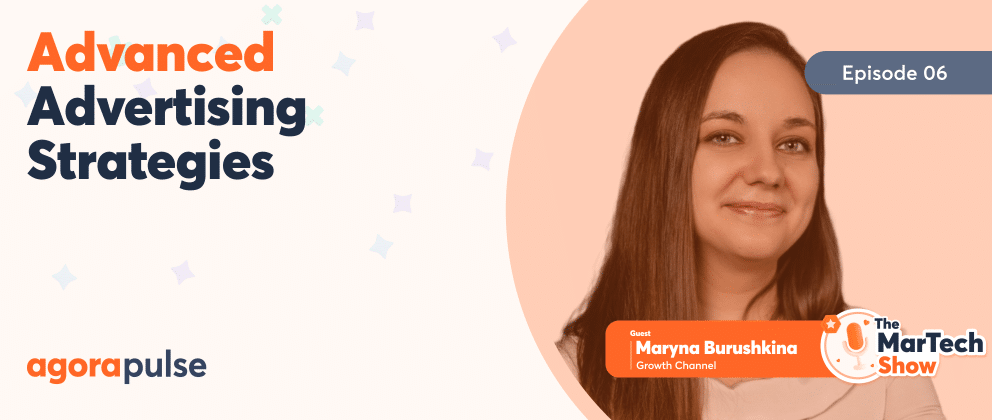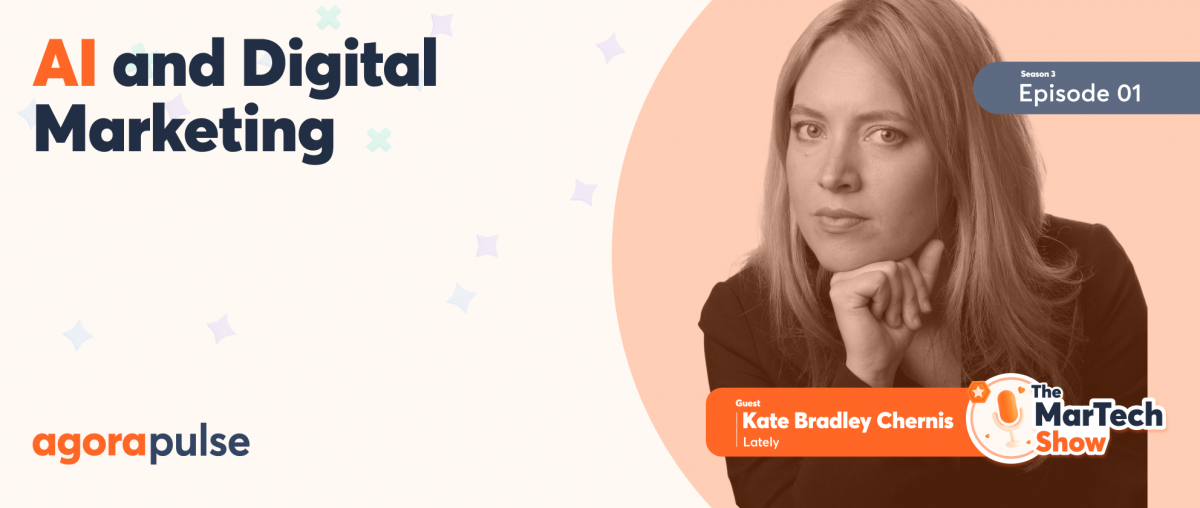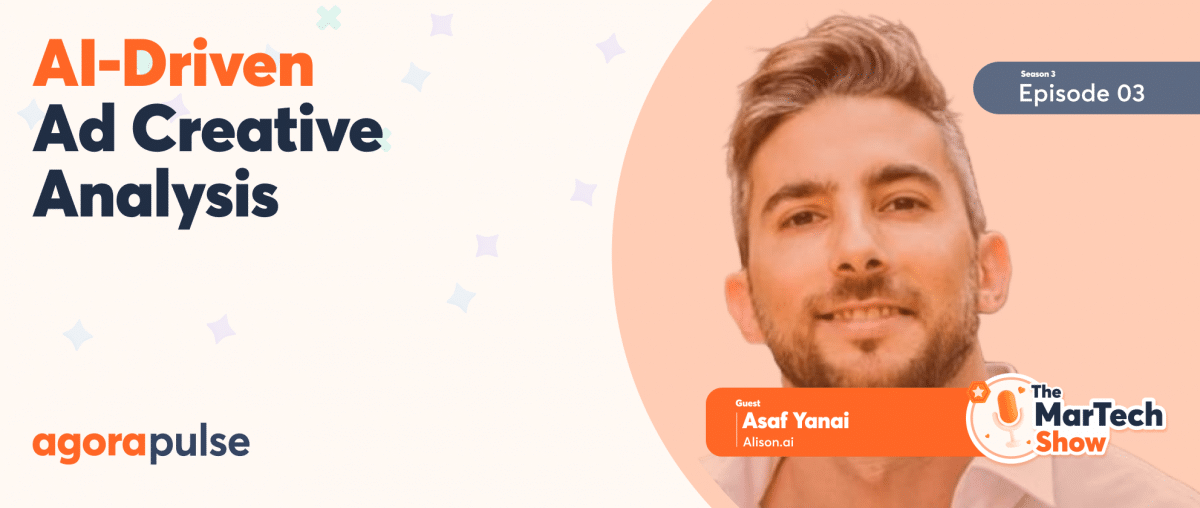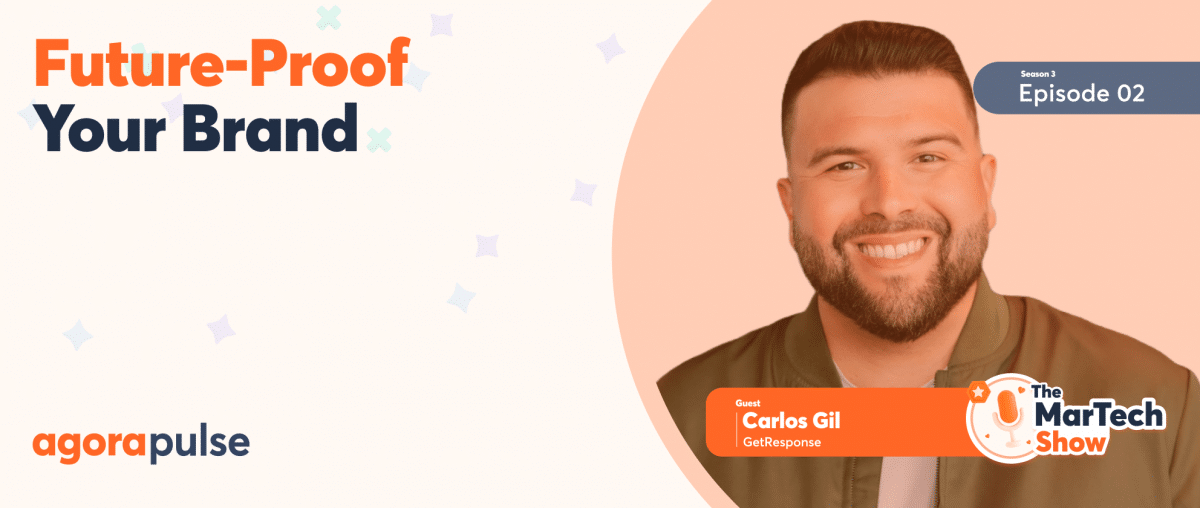Digital ad revenue is expected to exceed 600 billion worldwide this year. Yet—despite such a lucrative and growing industry—it seems like it’s never been more challenging to be a paid ads manager or consultant. We talked in a previous episode of The MarTech Show about iOS changes, cookies going away, and all the other challenges and changes facing digital advertising.
As a result, advertisers are turning to new strategies, employing new tools, and leveraging AI any way they can to find the seam. So, where should you turn your attention? And what advanced advertising strategies can we reliably turn to?
That’s what we’re covering in this episode of The MarTech Show.
The following transcript was taken from the full episode, which you can listen to here or read ahead.
Maryna Burushkina is the founder and CEO of Growth Channel AI and a digital marketing consultant and trainer. She has helped hundreds of multinational companies, such as Alliance and Phillips, and reshaped their marketing to drive accelerated growth over the last decade. And she is building an AI technology to solve marketing inefficiencies using the power of data and micro-segmentation.
Top Three Challenges of Advertisers Today
Mike Allton, host of The MarTech Show: Let’s set the stage a little bit.
How would you summarize the challenges that digital advertisers are facing today and in the coming months?
Maryna Burushkina: Yeah, that’s a big question. A lot of people are talking about it from all different angles, but I think there are a few things that I can summarize.
- Cookies going away. It’s a big deal for many companies that have been relying on third-party data segments to identify and target those audiences. And there are several alternative ways to reach those customers.
- Viewability. So we want to identify, “Did the people we were targeting see our ads that we spent the money on?”
- Measurement. “So we targeted these thousands/millions of users. Were they eventually the ones who signed up, or did they visit our store or purchase something?”
Those are the things that advertisers are struggling with. And there are different workarounds to tackle those.
But I would say those are the top three topics that I hear our advertisers bring up every single day.
The Game Plan Advertisers Can Follow
Mike Allton: What are some of the advanced strategies and solutions that might be available to advertisers now, from a general perspective?
Maryna Burushkina: Let’s say we talk about the first part, right?
How can you reach the audiences outside of using those third-party segments?
There are several ways at Growth Channel.
- The geofencing capabilities. Of course, it’s not the only one, but geofencing is a big one. You can do real-time geofencing of target strategic locations or even do it retroactively going back up to 12 months in the past. Identify, “Maybe those are industry events that people may have attended,” or “Maybe those are store locations that they go or do not go to,” and a few other parameters that you can layer on top of that.
- Contextual. Identify what kind of keywords are present on pages that you’re reading or what kind of shows you’re watching. Sometimes, we talk about Nike shoes, and then we see them on our Instagram feed or elsewhere. So contextual targeting does work pretty well.
- Predictive targeting. For example, Distillery is one of the data companies out there that have come up with a great algorithm for identifying and learning from first-party data sets. Which sites do they visit at what time? Which part of the site are they more engaged with? Identify the next placement of the ads without really knowing anything else about the user’s demographics. So, “What is the next site my target audience will visit at what time, and which part of the site they’re more engaged with?” to hit and place your ad right there. The third one is maybe a little bit more advanced, but one that is to look out for the CTRs. Engagement rates have been amazing from some of the case studies, which are 2x to 3x the general statistics.
Growth Channel’s Role in Audience Targeting
Mike Allton: I’m seeing more and more AI being leveraged to create some immersive and dynamic ads that would be living on other people’s websites—so banners or some other kind of embedded ad—but it knows where you’ve been, and it knows what your preferences are. It’s able to change the ad to correspond with who you are and what it knows about you [in] real-time, which is just fascinating.
But I want to get into how Growth Channel can help. We’ve talked broadly, but let’s get to how Growth Channel can play a role for those of us who want to be successful at advertising today.
Maryna Burushkina: In Growth Channel, we rely on micro-targeting and targeting very niche audiences to be able to hit them anywhere they go in the programmatic space.
Outside of social and search, there are so many other channels that are surrounding us. Everything from mobile apps, you can also listen to podcasts like Spotify and Pandora, watch Netflix and Hulu shows, or pass by digital billboards. A lot of the other channels in the digital spectrum are out there. And everything from audio ads, video ads, maybe banner ads more traditional—but even like native advertising on news-and-articles type of sites—all of those are embedded within Growth Channel and our micro-targeting solution goes kind of the next level.
Let’s say your advertiser is one of the stores. So using geofencing, for example, we can identify people who go to the competitor’s store who live within the area and are interested in buying that next pair of shoes because they’re browsing the web around those latest shoe trends (or something like this).
You can identify and target those people on those premium channels outside of the social and search ecosystem. So that’s just one of the things to describe how we tackle it. But, yes, we need micro-targeting.
You can have multiple campaigns, hyper-segmented into those micro-targeted audiences, and understand those audiences even before you launch those campaigns to make sure those are the exact ones you want to be targeting.
Digital Out-of-Home Marketing
Mike Allton: Did I hear you say drive by a digital billboard?
Maryna Burushkina: Digital billboards are one of the channels we have. It’s getting more and more popular, digital out-of-home advertising. You can think about it like digital billboards, like changing screens. You can think about the ones you see at the mall, you know, the digital stands, or the ones at the parking lot. You have TV screens within fitness centers, and even at bars and restaurants, you have those TV screens as well.
So digital out-of-home (DOOH) is a whole new game, and it’s lots of supply-side partners that are all embedded within our ecosystem.
I think we have about 20 supply-side partners that are embedded within DOOH advertising that are all available through Growth Channel. So, yeah, this is an up-and-coming channel. I would say it still comes after CTV advertising but still on a big rise in trends, together with audio advertising as well.
Mike Allton: I’m glad I asked you about that and that you mentioned it because I wouldn’t have thought about the panel displays in a mall or in a bar or someplace else that you might walk by when you say billboard. I’m thinking of the traditional vinyl placements on the side of the highway because I’m old enough. I used to buy that kind of thing for companies I used to work for.
And it was just all about the traffic volume, right? That this placement would get so many eyes or vehicles, per month. And that was what the pricing was like. And you’re telling me we can do so much more now.
Maryna Burushkina: You can target very specific audiences or even events. For example, INBOUND is coming back in September in Boston, at the convention center. So it’s a huge convention center, lots of stands, billboards, TV screens, and you can just target during the duration of the event and capture all of those tens of thousands of people right there.
That’s one of the easiest ways to capture them.
Other Tools like Growth Channel
Mike Allton: Going back to this Growth Channel overall, are there different segments, industries, or verticals that are a better fit for Growth Channel than others?
Maryna Burushkina: I like to work with B2C advertisers just because of the scale and how big the audience could be, even though you segment them into multiple different chunks.
B2B is also interesting. Event targeting is pretty big on our platform, but I would say the audience sizes are always much smaller, right?
I don’t have my favorite. I do love seeing the kind of raw results for our e-commerce advertisers. And I really see our retailer’s advertising when we tell them, “Oh, these people actually look up your store after seeing our ad.” So I love seeing those. If I have to pick some, those are my favorites.
But overall, it depends also on the product or service that is being promoted.
We also have several nonprofits advertising on our platform, some government campaigns for advocacy, so there’s a whole lot of different things going on around like different targeting strategies to reach those niche audiences.
But, yeah, I would say retailers and e-commerce are probably some of my favorites.
Get Started with Growth Channel (As an Advertiser or an Agency)
If someone wanted to get started with Growth Channel today, what would an advertiser need to know or have in place already to take advantage of your platform?
Maryna Burushkina: A few things.
One, a landing page ideally optimized for your KPI. So for example, if you want to drive conversions for leads, make sure you have a landing page that’s optimized for conversion or if it’s a purchase, make sure it’s easy to purchase your product on the page you’re driving traffic to. So that’s one.
The second one is the creative or ad. As I mentioned shortly earlier, we support multiple different formats, so everything from traditional banners to videos, audio, ad tags, native ads, or HTML5. So we support all the standard, programmatic ad formats that you can easily upload inside the platform.
And three is the budget. Make sure you know the budget and the KPI that you’re going for. Input it into your campaign. There is no minimum. So it’s pretty easy to set up any campaign, even on the premium channels.
Those are the three things to keep in mind. If you’re looking to track purchases or conversions, we highly recommend you place the pixels on that landing page you have there and potentially other pages on the site, depending on what the campaign journey is.
But, yeah, those are it. It’s pretty easy to get started. Some people get started in 5 to 15 minutes.
Mike Allton: Now you’ve talked about working directly with retail brands and even some other industries. What about agencies?
Are agencies using Growth Channel and any particular nuance there to help them?
Maryna Burushkina: Oh, yes. We love working with agencies. Most of our campaign activations are happening through agencies. Early on, the experts in advertising often—when we speak directly to the brands—they are like, “I don’t know anything about it, or very little.”
Although sometimes we would work with internal marketing teams, it’s rarely the time when they would engage with us directly. Most of the time, we would either direct them to an agency partner, or an agency would be the one that would already manage the client campaign.
Agencies are the gold here.
A few things that agencies tend to like on our platform: One [is] all the programmatic ecosystem is built inside Growth Channel. That means all the premium demand side platforms, if you’re running programmatic ads, so everything from the Trade Desk to DV360, Zender, Yahoo, DSP, Credio, and many others are all built-in inside Growth Channel.
So you have access to all of that premium inventory within our platform. You also have all the DMP, major DMP partners like Nielsen, Bonvora, Oracle, BlueKai, and many others also able through Growth Channel.
You can build those custom audiences when you need them, build and attribution and measurement when you need it. So, everything you need for programmatic is already inside Growth Channel. Our agency saves about 30 percent of its resources because everything is already connected inside the ecosystem.
Another thing is that it is pretty easy to add a margin. If you’re charging your clients, a certain margin [is] based on the media spent, so you can add it within Growth Channel.
So it’s reflected within the reports, and we also have a white-label possibility for those reports. If you’re interested in a subdomain, change the colors from green to purple, blue, whatever. It’s pretty easy to set up. It takes about five minutes.
Mike Allton: I want to go back to something you just said because it’s extremely powerful. You talk about how using Growth Channel, you already have these other platforms built in.
For most of us who are doing our advertising on that platform, we would typically have our own Facebook ads manager, our own TikTok ads manager, and our own YouTube ads manager. And it’s so uncommon then to go into all these other areas that you talked about because you have to create accounts on each one.
So, just to reemphasize, you said you already support all these other platforms and you talked about CTV earlier.
Do you support CTV as well?
Maryna Burushkina: Yeah. So people can advertise on CTV and even linear TV. Digitalad.com, audio ads, like streaming music, podcasts, and streaming radio. You can advertise in mobile apps, on websites like Forbes, Fast Company, etc. You can even advertise in-game, so like Twitch, for example. So the sky’s kind of the limit.
There are so many different advertising channels outside of the traditional social and search. So anything programmatic, you have it inside.
Mike Allton: That’s amazing. So to give a little bit of analogy, we’re using StreamYard right now as our studio. We stream into SQL for the webinar platform. We stream into the Facebook group. And, if I wanted to, I could stream to YouTube, Twitter, LinkedIn, and all these other platforms that allow that. Growth Channel is very similar, just from an advertising perspective, putting the ads on Growth Channel. You’re distributing them to all these different platforms simultaneously.
What advice do you have for advertisers in general who are struggling to keep up with all these things that are going on?
The lack of cookies … I know Google has pushed that back a year or so, but it’s the Sword of Damocles that is just hanging over our heads. We know the cookies are going to be gone at some point. It’s just a matter of time.
What advice do you have for them?
Maryna Burushkina: Don’t spend too much time thinking about, “Oh, my cookies are going away.”
Spend a little bit more time emphasizing, “What is my audience? Like, who is, who are they? What do they like? Where do they hang out? What do they listen to? What do they read?” to understand their persona.
And once you have done that part, it will be pretty easy to identify contextual targeting or targeting them on specific sites and channels. even like looking at targeting them, maybe different locations that they visit, or even doing that predictive modeling, in place.
You can also easily build lookalike audiences if you have significant first-party data that you can use as source data to identify those. There are plenty of opportunities outside of relying on those cookies that you can really reach that audience.
And outside of that, I would also focus on—once you’re ready to run that campaign—one thing that we always talk to our advertisers, which is pretty simple, but not everyone thinks about it as much, is, “What is your objective, and can you measure it?”
That’s so important. You have to know it before you start running your campaign. I’m optimizing for awareness. So am I going to be just looking at impressions, clicks, and engagement, or am I optimizing for traffic to my site?
Let’s place that pixel on the website to track and measure it and see how it ends up. Or are we optimizing for conversions? You need to know what that KPI is. Am I looking for a $25 CPA or a hundred dollars CPA target?
Think about it before you launch any campaign and make your choice of the ad creative, channel, and audience also based on that objective: The target is so important but often overlooked.
What Smaller Advertisers Can Do
Mike Allton: We’ve got a question from our live audience, from Damien Hardy. And he asks, “Pixels are often dependent on third-party cookies. Do we need to move everything to conversions API with consent 2. 0?” I’m not sure if you’re familiar with that. And if you’re not, that’s okay.
But then he says, “What about smaller advertisers who can’t afford that?”
Maryna Burushkina: Yes. So, with Growth Channel, it’s one very small script tag that needs to be placed. We do not run on cookies, so don’t worry about that. We work mainly on device IDs and then cross-device ID matches. So we built our audience graph where we can identify, the device matches from CTV to mobile, to audio, and then efficiently target that specific target audience and measure the impact down to your website purchases, as an example, or lead signups or whatever your objective is there.
What’s Going on for the Rest of 2024?
Mike Allton: I just have one more question for you, Maryna.
What’s on your roadmap?
What’s coming with Growth Channel?
Maryna Burushkina: I would say that in the next quarter or so, we plan to expand with e-commerce apps. So, we’re looking into potentially getting into the Shopify app marketplace or BigCommerce app shop, marketplace. So, we want to make it easier for those e-commerce brands to start advertising with Growth Channel.
Next year, we plan to scale towards social because it’s becoming harder and harder to target the right people on social media, like Meta ads, for example, and then measure those results, down to—let’s say purchases, etc.—that is interconnected also with maybe some other channels of yours.
That being said, it’s more like a longer-term because the structure of, technically speaking, the setup for social media ads, also because you, as advertisers, will likely connect your own account, versus having programmatic all built in, is slightly different. So it’s more like a Q1 thing (if we’re lucky), but something that we’re exploring.
Mike Allton: Terrific. That sounds fascinating. We’ll have to have you back once you’ve got your big commerce connected.
We’ve already talked with them on our other retail podcast because that’s an audience that we’re talking to a lot. We’ve talked about Feedonomics and using those kinds of tools to keep your products up to date on all of those different platforms and having a platform like Growth Channel that has those ads going out programmatically and driving folks to your channels where they can go to your online shop—not have to go, but they can just go to your shop, your Facebook shop, your TikTok shop—and so on and make that purchase is going to be phenomenal. So we’ll have you back then.
Maryna, you’ve been fantastic. This has been such an interesting conversation for folks who want to learn more, and who want to get more involved.
Get Connected with Maryna
Where can they go to reach out and ask questions?
Maryna Burushkina: Yeah, definitely check our website. And if you’re interested in learning more, you can schedule a demo. And if you want to geek out with me personally, you can connect with me on LinkedIn. It’s my full name, Maryna Burushkina.
Mike Allton: Terrific. We’ll have all the links in the show notes.
And, folks, if you want to continue this conversation, join us in the Social Media Pulse community. We’d love to have you there.
(And by the way, we had a special podcast-only episode that you have to listen to. It’s with Scott Brinker, the chief MarTech and the chief Ecosystem Officer of Hubspot, his annual MarTech landscape report just dropped over 14,000 marketing technology apps, and it’s just mind-boggling. Not only how many apps, but also what’s happening, and how AI is driving this explosion of apps. This is a conversation you’re not going to want to miss. Scott breaks it all down for us. He talks about composability and so many topics that frankly, as marketers, we need to understand. So subscribe to that podcast wherever you enjoy great podcasts.)
We’ll see you next time.
Thank you for listening to another episode of the MarTech Show, hosted by Robin Dimond and Mike Allton, powered by Agorapulse, the number one rated social media management solution, which you can learn more about at Agorapulse.com.
If you want to make sure you’re part of our audience during live weekly broadcasts, take a look at our calendar at agorapulse.com/calendar, or click the subscribe button in your email. Once you register for any of these events, is there a particular tool or topic you’d like to see us talk about? Or perhaps you think your solution should be featured? Email me at mike@agorapulse.com.
